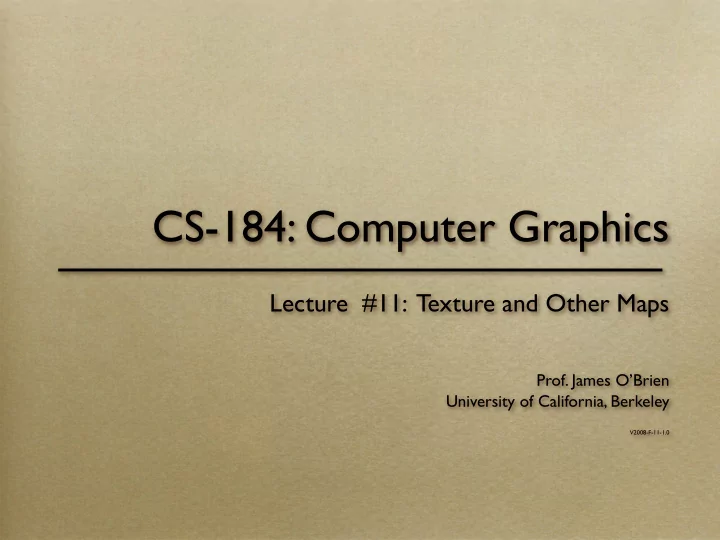

CS-184: Computer Graphics Lecture #11: Texture and Other Maps Prof. James O’Brien University of California, Berkeley V2008-F-11-1.0
Today Texture Mapping 2D 3D Procedural Bump and Displacement Maps Environment Maps Shadow Maps 2
Surface Detail Representing all detail in an image with polygons would be cumbersome Specific details Structured noise Pattern w/ randomness Section through volume Bumps 3
2D Texture Mapping of Images Use a 2D image and map it to the surface of an object Color Specular Bump 4
2D Texture Mapping of Images Example of texture distortion 5
Texture Coordinates Assign coordinates to each vertex Within each triangle use t linear interpolation s Correct for distortion! 6
MIP Map Pre-compute filtered versions of the texture A given UV rate is some level of the texture Tri-linear filtering UV × map level 7
Procedural Textures Generate texture based on some function Well suited for “random” textures Often modulate some noise function 8
Assigning Texture Coordinates Map a simple shape onto object by projection Sphere, cylinder, plane, cube Assign by hand Use some optimization procedure 9
Repeating Textures Image Tiles allow repeating textures Images must be manipulated to allow tilling Often result in visible artifacts There are methods to get around artifacts.... 10
Repeating Textures Image Tiles allow repeating textures Images must be manipulated to allow tilling Often result in visible artifacts Artifacts not an issue for artificial textures 11
Non-Color Textures Color Specular Bump 12
Bump Mapping No bump mapping With bump mapping Images by Paul Baker www.paulsprojects.net 13
Bump Mapping Add offset to normal Offset is in texture coordinates S,T,N Store normal offsets in RGB image components Should use correctly orthonormal coordinate system Normal offsets from gradient of a grayscale image b ( u , v ) = [ s , t , n ]( u , v ) = ∇ i ( u , v ) ∂ � T ∂ u , ∂ ∇ = ∂ v 14
Bump Map Example Catherine Bendebury and Jonathan Michaels CS 184 Spring 2005 15
Displacement Maps Actually move geometry based on texture map Expensive and difficult to implement in many rendering systems Note silhouette Bump Displacement 16
Environment Maps Environment maps allow crude reflections Treat object as infinitesimal Reflection only based on surface normal Errors hard to notice for non-flat objects 17
Environment Maps 18
Environment Maps (u,v) = (1,1) x = y= z z u = y + x y 2 x x right face has x > |y|, x > |z| v v = z + x u 2 x (u,v) = (0,0) x = -y= -z 19
Shadow Maps Pre-render scene from perspective of light source Only render Z-Buffer (the shadow buffer) Render scene from camera perspective Compare with shadow buffer If nearer light, if further shadow 20
Shadow Maps Shadow Buffer Image w/ Shadows From Stamminger and Drettakis SIGGRAPH 2002 Note: These images don’t really go together, see the paper... 21
Deep Shadow Maps Some objects only partially occlude light A single shadow value will not work Similar to transparency in Z-Buffer From Lokovic and Veach SIGGRAPH 2000 22
Recommend
More recommend